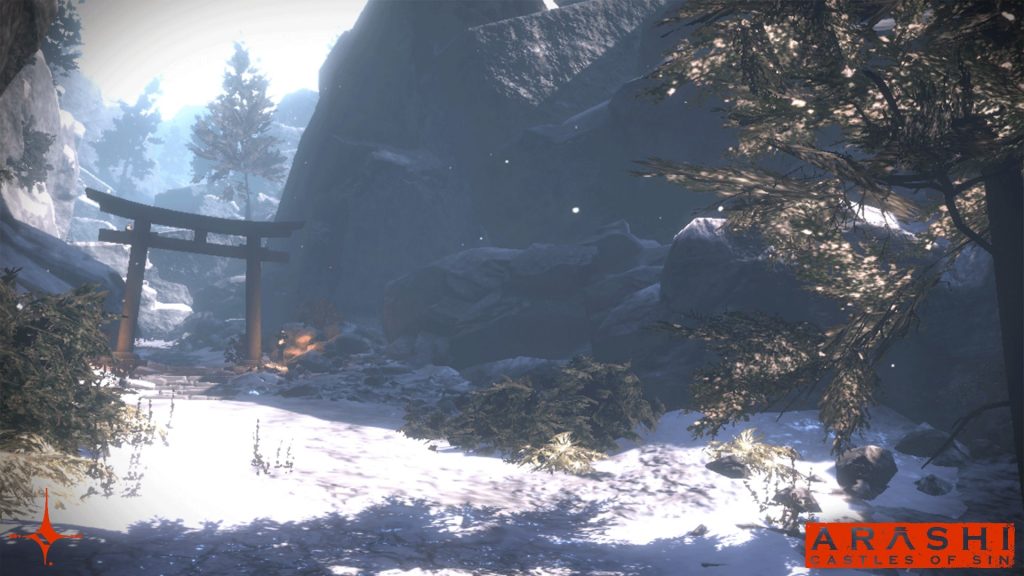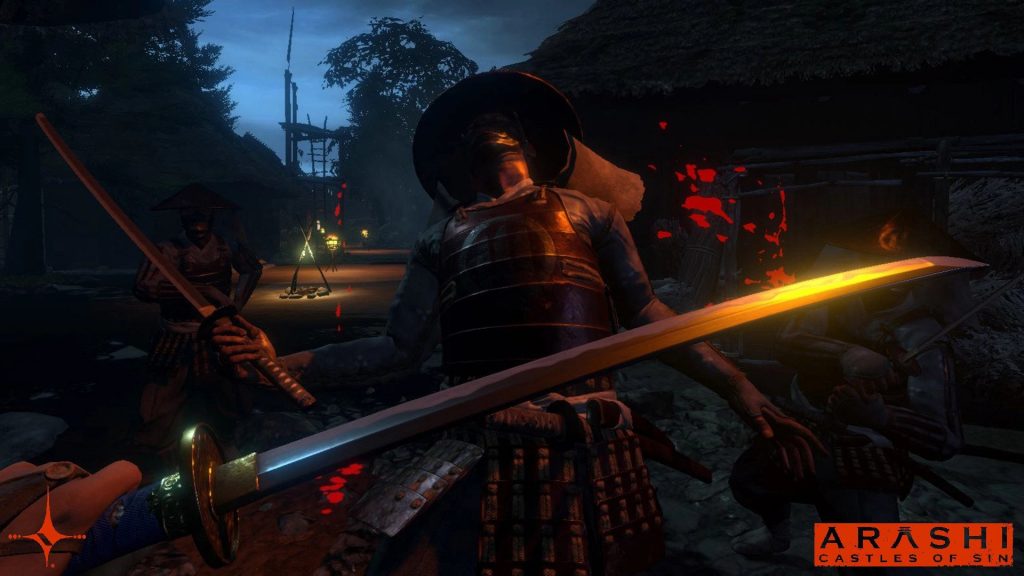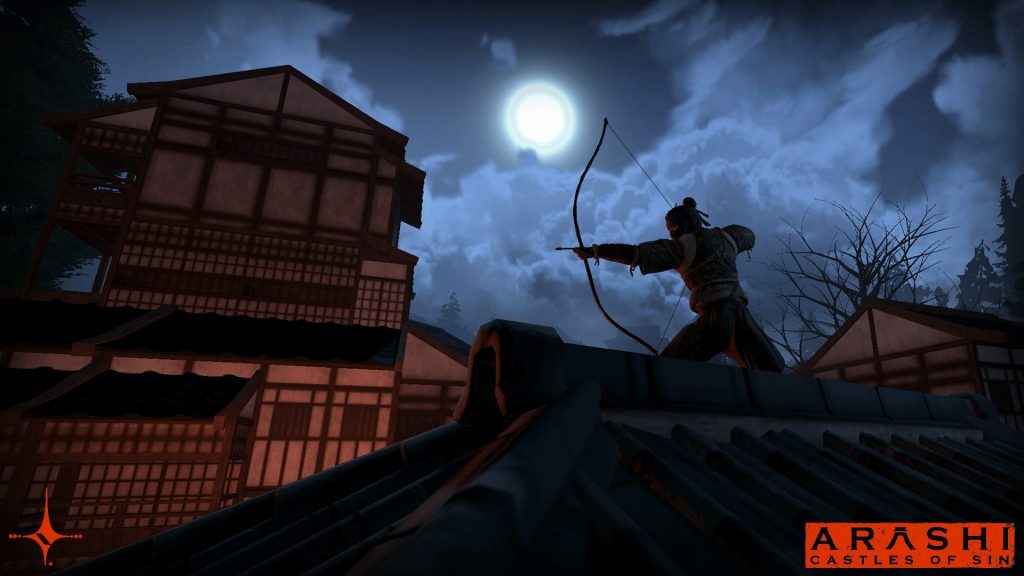*Disclaimer: Arashi: Castles of Sin review code was provided by Endeavour One Inc. for the purposes of this review. That being said, all opinions expressed in this review are entirely that of the author.
Arashi: Castles of Sin has been on my radar since its announcement back at the beginning of June this year. The brief one-minute trailer immediately grabbed my attention; a samurai stealth game that lets you use a variety of weapons and gadgets, including a grappling hook? Yes please!
Well, Arashi dropped last week, seemingly out of nowhere and with very minimal fanfare. Maybe that was a sign for what was to come. But a game that opens on you playing fetch with a wolf is sure to be good, right?
Not The Shiniest Throwing Star
Arashi (on a base PS4) is, quite simply, an ugly game. The vast majority of object and environmental textures are extremely unclear and muddy. Rock faces appear as though they are jagged 2D walls, tree branches and leaves are grainy and flat, and objects like ropes and logs seem as though they’ve been ripped straight from GoldenEye 64. Now, PlayStation VR games are renowned for their outdated graphics and often unrealistic environmental textures, but Arashi‘s visuals are distinctly below average for a modern PSVR game.
Thankfully, Arashi‘s character models fare a little better. Enemies, while lacking much visual or mechanical variation, do belong in a modern VR game. Light reflects naturally off enemies’ armour, a nice splash of colour helps to make them pop against the muddy backdrops, and combat and patrol animations seem fluid and fairly responsive.

Unfortunately, Arashi does suffer from a few technical issues. Throughout my playthrough, I experienced constant pop-in. Trees, torches, buildings, enemies, just about everything over a metre in front of me would awkwardly jut into frame as I approached. Enemy detection was also a little buggy, with some enemies not noticing that I’d stabbed them in the back until the second hit. Even my lovable wolf companion was hit with some bugs; I repeatedly found her perched vertically up a wall and phased through doorways. While these issues are nowhere near as game-breaking as the recently released Sniper Elite VR, Arashi is also trying to accomplish much less in the way of gameplay mechanics and visual fidelity.
Streamlined For Newcomers
A VR game is much more than its graphics. And, fortunately, Arashi‘s general movement mechanics and control scheme are its saving grace, at least for VR newcomers. In general, Arashi only requires the use of five buttons on your PS Move controllers: the Move button on your left and right hand (used to move and jump, respectively), the Triangle button on your right hand (used for swapping weapons and items), and the triggers on both controllers, which are used to grab things in the environment and use various gadgets. While there are more buttons to use, just these five are all that you need to get the most out of the game.
Similarly, Arashi employs several mechanics that seem specifically designed to make the game more accessible to those who are new to VR. For instance, along with the now-standard comfort settings, Arashi uses an aim assist mechanic when you are throwing shurikens or firing your bow. This level of accessibility suits this game perfectly as throwing in VR is almost-always a frustrating task, and the last thing you should be worrying about as a highly-trained ninja.
The streamlined control scheme and simplified mechanics helps to keep Arashi enjoyable for all types of players, no matter their VR pedigree. But this streamlined sword is double-edged.
Mindless Slashing
By far the weakest element of Arashi is its weightless combat. While primarily a stealth game, occasionally you will be forced into one-on-one duels with some enemies. The gameplay in these moments is extremely simple; block an incoming attack and slash at them when they’re staggered. This mechanical simplicity isn’t necessarily a bad thing, but its implementation and execution certainly is.
Consistently during my playthrough opponents would come too close to me, rendering my blocks unintelligible. At first I thought it was my PSVR camera, but after around half an hour of adjusting and another four hours of gameplay I’m fairly confident in saying that it wasn’t on me. What begins as a minor annoyance quickly turns into a major grievance as every boss in the game forces you into a duel, ensuring that you’ll be replaying those fights over and over again.

Put simply, the combat doesn’t feel fun, even when it works properly. The hit detection is the main culprit in making the combat feel weightless and cheap. Often you’ll find yourself blocking an attack and being unsure on whether you connected with your opponent’s sword. Only a light murmur can be felt in the controller and the animations of your enemy do little to convey that you’ve realistically knocked them off-guard. A flash of a flat, blue JPEG on your enemy’s sword is all the indication you receive. To make matters worse, when you do stagger your opponent and take a swing it’s also tricky to know when you’ve hit them as only a small spurt of bright red “blood” appears, often appearing nowhere near you point of impact.
Arashi‘s combat is unsatisfying and regularly frustrating, making the game feel incredibly cheap due to its weightlessness, especially when compared to its contemporaries like Walking Dead: Saints and Sinners.
Enough To (Grappling) Hook You
Despite my pretty sizeable grievances with the game’s combat and graphics, there is enough within Arashi to keep you engaged in its pretty short ~6-hour runtime. Despite it, much like the rest of the game, being pretty barebones, the stealth gameplay that dominates Arashi‘s runtime is genuinely very enjoyable.
Most of your gameplay will consist of classic stealth-game mechanics like dashing between abnormally tall bushes, distracting guards, and silently taking down enemies with deadly precision. Now, I’m not a massive stealth-game fan, but there’s something intrinsically cool about sneaking around and tactically eliminating enemies in VR. This inherent enjoyment is enhanced exponentially when more weapons and items are introduced into the game.
Over the course of the game you’ll unlock a multitude of various stealthy and explosive gadgets. These range from a blow dart to an explosive grenade to a Flintlock pistol. Although the majority of these gadgets have generally the same effect (a blow dart does the same as the poisonous food, for example), it is undeniably cool to fling a shuriken, shoot an arrow or throw a gas grenade in VR.

Arashi‘s level design, for the most part, is also a highlight. All of the five levels follow the same structure: a few stealth sections set in open spaces, one or two indoor sections, then a boss fight. It’s those first open-area stealth sections in which Arashi‘s stealth mechanics really shine. In quite a few of these environments you’re able to hop onto roofs, dash down into dojos, and fly between towers with ease with your grappling hook. The fluidity of your movement and the open-ended nature of these environments leads to some really unique and intense moments. And thanks to the aforementioned streamlined mechanics and controls you’ll be dashing between and around enemies easily in no time at all.
It’s not easy to get stealth right in VR, but regardless of its faults, Arashi: Castles of Sin manages to keep its stealth sections engaging and rewarding with every encounter, in spite of a lack of any truly complex or distinctively unique mechanics.
Disappointingly Average
When reviewing a game, I’m always aiming to be as positive as I possibly can be. Even in the note-taking phase, I’m always making sure that I’m detailing every aspect that I enjoy about the experience. But Arashi: Castles of Sin is a difficult one to praise. The stealth gameplay on offer here is undoubtedly fun and the experimentation available with weapons and items is gratifying, but there isn’t really anything all that unique about Arashi. And, what is here, no matter how enjoyable, is still extremely barebones when compared to recent PSVR offerings.
It’s clear that there were some really interesting concepts and ideas at the heart of this game, but the final execution of it all falls just a little too flat.
Final Verdict: 6/10
Arashi: Castles of Sin is available now on PlayStation VR only.
Words By Cameron Swan
